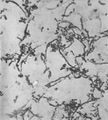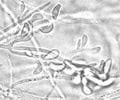Search results
From MicrobeWiki, the student-edited microbiology resource
Page title matches

File:Bacilli P7060990 (2).jpg (714 × 579 (139 KB)) - 21:19, 2 May 2015
File:R. dentocariosa-cocci and bacilli forms.jpg (328 × 364 (47 KB)) - 01:12, 23 September 2016
Page text matches

File:Capent.jpg Note colorless capsules surrounding purple bacilli.(311 × 235 (56 KB)) - 04:57, 29 August 2007
File:02-0485 1b.jpg ...l-Neelsen stain of the same nodule, showing abundant colonies of acid-fast bacilli in the necrotic subcutaneous tissues (original magnification 100x).(600 × 428 (58 KB)) - 01:59, 27 August 2009
File:20101017 175758 Bacilli.jpg Some Gram-positive bacilli, presumably of the genus <i>[[Bacillus]]</i>.<br/>(300 × 251 (17 KB)) - 00:55, 2 May 2012- Class: Bacilli1 KB (226 words) - 14:07, 22 February 2011
- Domain: Bacteria; Phylum: Bacillota; Class: Bacilli; Order: Bacillales; family: Staphylococcaceae [Others may be used. Use [ht2 KB (222 words) - 22:39, 20 December 2022
- ...mission electron microscopes. The bacteria was found to be a gram-negative bacilli. Genome sequencing was analyzed using 16S rRNA. Findings showed the bacteri Pseudoxanthomonas winnipegensis is gram-negative bacilli with a yellowish pigment. Additionally, research has found they are aerobes4 KB (580 words) - 22:36, 13 December 2022
- <I>Prevotella micans</I> is a gram-negative bacilli that is primarily an obligate anaerobe. The species was isolated from necro <I>Prevotella micans</I> is a non-motile, gram-negative bacilli. Cell size measures 1.5-5μm long by 0.7μm wide, and are normally arra4 KB (627 words) - 15:45, 22 February 2016
- ...e diameter had increased to 1.8–2.2 mm (4). The gram-negative bacteria are bacilli or circular shaped that consist of a high convex to pyramidal, with an off- ...a Fusca and Prevotella Scopos are anaerobic, non-motile, and gram-negative bacilli (4). The phylogenetic analysis of the 16Sr RNA gene sequence showed that st6 KB (912 words) - 01:33, 13 March 2014
- Bacteria; Bacillota; Bacilli; Bacillales; Alicyclobacillaceae; Alicyclobacillus; A. ''acidoterrestris'' A. ''acidoterrestris'' is an aerobic, gram positive, thermoacidophilic bacilli that produces endospores. It can survive in acidic environments down to 2.55 KB (724 words) - 16:28, 19 April 2022
- Bacteria; Firmicutes; Bacilli; Bacillales; Bacillaceae; Bacillus3 KB (340 words) - 20:53, 22 October 2015
- Domain: Bacteria, Phylum: Firmicutes, Class: Bacilli, Genus: Exiguobacterium, Species: Unknown2 KB (328 words) - 20:45, 30 October 2015
- Class: Bacilli2 KB (333 words) - 18:25, 25 August 2020
- ...dominantly Gram-negative cocci, with a few particularly long Gram-negative bacilli.<br/>Numbered ticks are 11 µM apart.<br/>Photograph by [[User:Blayloc3 KB (442 words) - 14:37, 28 September 2015
- Bacteria; Firmicutes; Bacilli; Bacillales; Bacillaceae; Amphibacillus ...o their natural environment. Before the isolation of ''A. fermentum'', all bacilli isolated from alkaline lakes have been obligate aerobes [[#References|[2]]]12 KB (1,565 words) - 04:34, 27 December 2012
- Bacteria; Firmicutes; Bacilli; Bacillales; Staphylococcaceae; Staphylococcus3 KB (328 words) - 20:50, 22 October 2015
- *Class:Bacilli <br />3 KB (362 words) - 19:36, 6 May 2016
- ...of a microscope. Comes in various different shapes, spheres (cocci), rods (bacilli), and spirals. But, the color depends on the specific strain and conditions3 KB (471 words) - 02:54, 13 December 2023
- Bacteria; Firmicutes; Bacilli; Bacillales; Bacillaceae; <i>Bacillus</i>; <i>Bacillus megaterium</i>3 KB (484 words) - 15:16, 29 September 2015
- Domain:Bacteria; Phylum: Firmicutes; Class:Bacilli; Order: Bacillasles; Family: Bacillaceae; Genus:Bacillus; Species: Bacillus ...that is for bacteria, and is designed to isolate Gram-negative and enteric bacilli on whether or not they could ferment lactose) was possible. Because of it s9 KB (1,316 words) - 15:10, 22 February 2016
- ...pe and size based on the environment. In this case, both the gram negative bacilli and gram variable staining diplococcic were present in the smear [2]. On bl ...ter pneumosintes gen. nov., comb. nov., nom. rev., Anaerobic gram-negative bacilli from the human gingival crevice. Int J Syst Bacteriol. 1994;44:187–92.]6 KB (908 words) - 20:03, 11 December 2015
